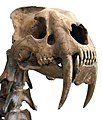From Wikipedia, the free encyclopedia
The Nimravidae are the oldest, entering the landscape around 42 mya and becoming extinct by 7.2 mya. Barbourofelidae entered around 16.9 mya and were extinct by 9 mya. These two would have shared some habitats.
Contents
Morphology
These subfamilies evolved their saber-toothed characteristics entirely independently. They are most known for having maxillary canines which were, in some species, up to 50 cm (19.7 inches) long and extended down from the mouth even when the mouth was closed. Sabre-toothed cats were generally more robust than today's cats and were quite bear-like in build. They were believed to be excellent hunters and hunted animals such as sloths, mammoths, and other large prey. Evidence from the numbers found at La Brea Tar Pits suggests that Smilodon, like modern lions, was a social carnivore.[7]The first late saber-tooth instance is a group of animals ancestral to mammals but not yet mammals. Known as synapsids or mammal-like reptiles, they were one of the first groups of animals to experiment with specialization of teeth and many had long canines. Some had two pairs of upper canines with two jutting down from each side, but most had one pair of upper extreme canines. Because of their primitiveness, they are extremely easy to tell from machairodonts. With no cononoid process, many sharp "premolars" more like pegs than scissors, a very long, lizard-like head are among several things that mark them out.
The second appearance of long canines is Thylacosmilus. Thylacosmilus is the most unique of the saber-tooth mammals and is also easy to tell apart. It differs from machairodonts in a possessing a very prominent flange and a tooth that is triangular in cross section. The root of the canines is more prominent than in machairodonts and a true sagittal crest is absent.
The third instance of saber teeth is from order Creodonta. The small and slender Machaeroides bore canines that were thinner than in the average machairodont. Its muzzle was longer and narrower.
The fourth saber-tooth appearance is the ancient family of carnivores, the nimravids and they are notoriously hard to tell apart from machairodonts. Both groups have short skulls, tall sagittal crests, and the general skull shape is very similar. Some have distinctive flanges, some have none at all, so this confuses the matter further. Machairodonts were almost always bigger, though, and their canines were longer and more stout for the most part, but exceptions do appear.
The fifth appearance is the barbourofelids. These carnivores are very closely related to actual cats, and as such, they are hard to tell apart. The best known barbourofelid is Barbourofelis, which differs from most machairodonts by a mandible that is much heavier and more stout, smaller orbits, massive and almost knobby flanges, and canines that are farther back. The average machairodont has well-developed incisors, but barbourofelids were more extreme.
The sixth and last of the sabertooth group to evolve were the machairodonts themselves.
-
-
-
3rd Saber-tooth Instance: Creodonta, family undetermined. Machaeroides skull.
-
4th saber-tooth instance: Nimravidae (Carnivora). Hoplophoneus primaevus skull and upper cervical vertebrae.
-
5th saber-tooth instance: Barbourofelidae (Carnivora). Barbourofelis skeleton.
-
6th saber-tooth instance: Felidae (Carnivora). Smilodon skull and upper cervical vertebrae.
Prey
| This section does not cite any references or sources. (June 2013) |
A disputing view of the cat’s hunting technique and ability is presented by C.K. Brain in “The Hunters or the Hunted?” in which he attributes the cat's prey-killing abilities to its large neck muscles rather than its jaws. Large cats use both the upper and lower jaw to bite down and bring down the prey. The strong bite of the jaw is accredited to the strong temporalis muscle that attach from the skull to the coronoid process of the jaw. The larger the coronoid process, the larger the muscle that attaches there and therefore the stronger the bite. As C.K. Brain points out, the saber-toothed cats had a greatly reduced coronoid process and therefore a disadvantageously weak bite. The cat did however have an enlarged mastoid process, a muscle attachment at the base of the skull, which attaches to neck muscles. According to C.K. Brain the saber-tooth would use a “downward thrust of the head, powered by the neck muscles” to drive the large upper canines into the prey. This technique was “more efficient than those of true cats”.
Ecology
Why does the adaptation of saber-like canines come about at least four different times in different families such as nimravids, marsupials, and felids? The similarity in all these unrelated families involves convergent evolution of the saber-like canines as a hunting adaptation. Meehan et al. note that it took approximately 8 million years for a new type of saber-toothed cat to fill the niche of an extinct predecessor in a similar ecological role; this has happened at least four times with different families of animals developing this adaptation. Although the adaptation of the saber-like canines made these creatures successful, it seems that the shift to obligate carnivorism, along with co-evolution with large prey animals, led the saber-toothed cats of each time period to extinction. As per Van Valkenburgh, the adaptations that made saber-toothed cats successful also made the creatures vulnerable to extinction. In her example, trends toward an increase in size, along with greater specialization, acted as a "macro-evolutionary ratchet": when large prey became scarce or extinct, these creatures would be unable to adapt to smaller prey, consume other sources of food, and would be unable to reduce their size so as to need less food. The adaptations that would bring these creatures to apex predator status and dominance would lead them to their evolutionary doom.









No comments:
Post a Comment